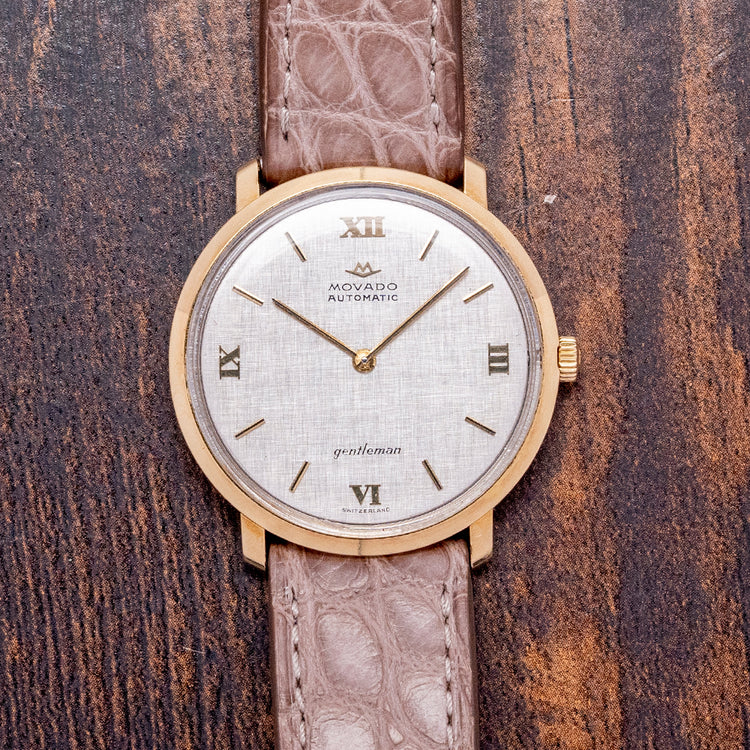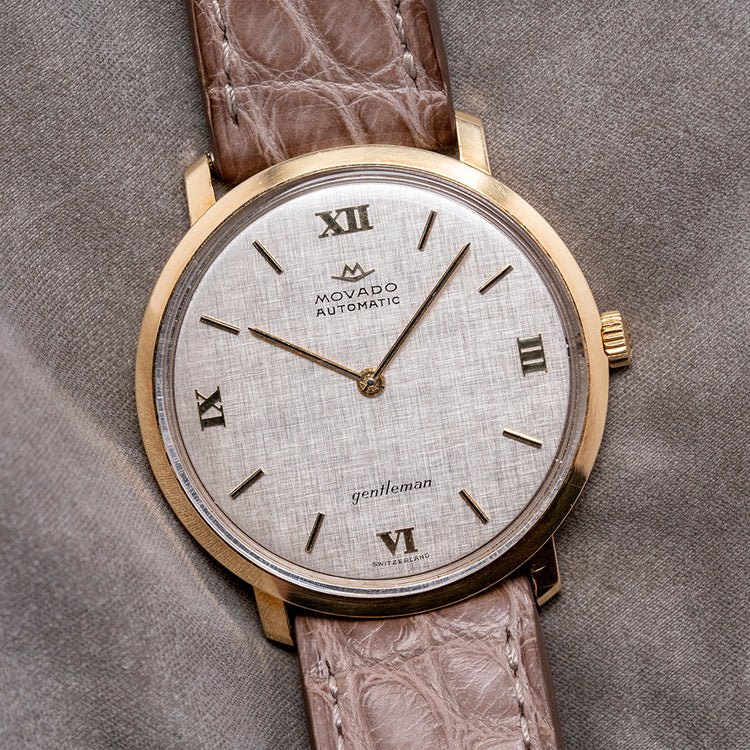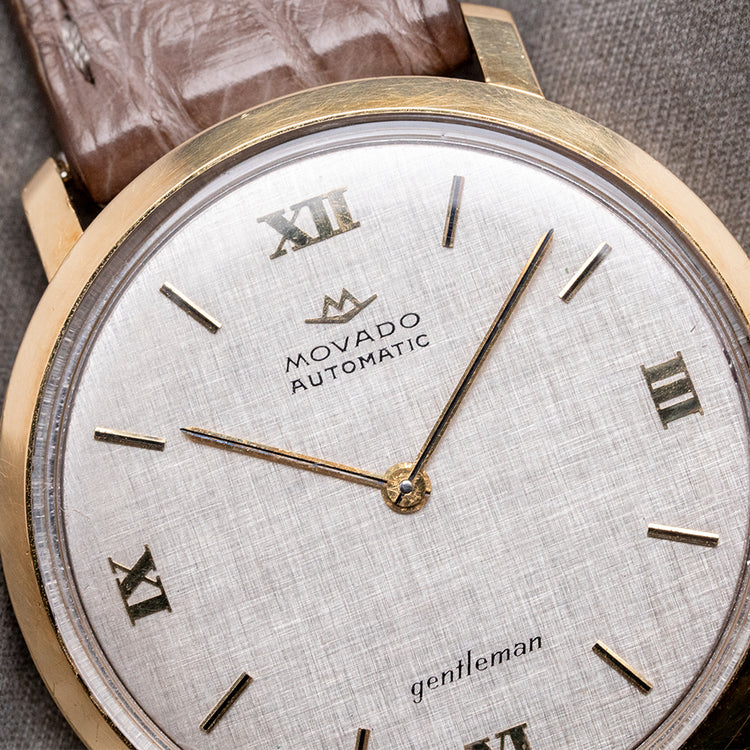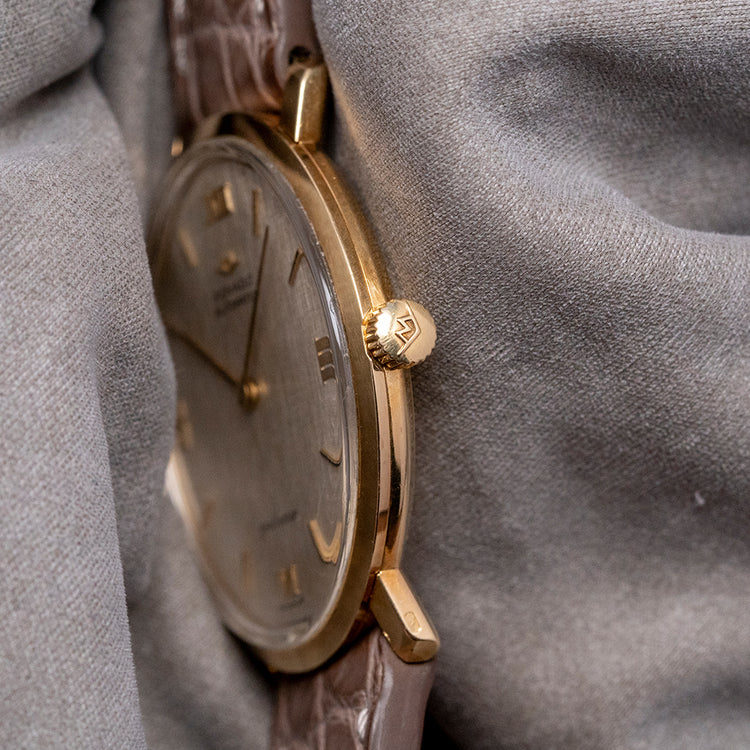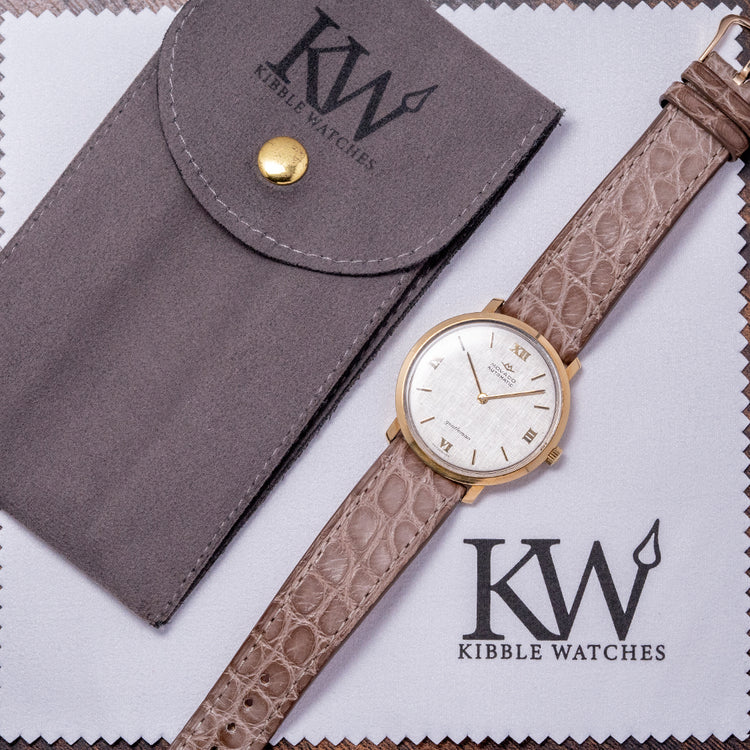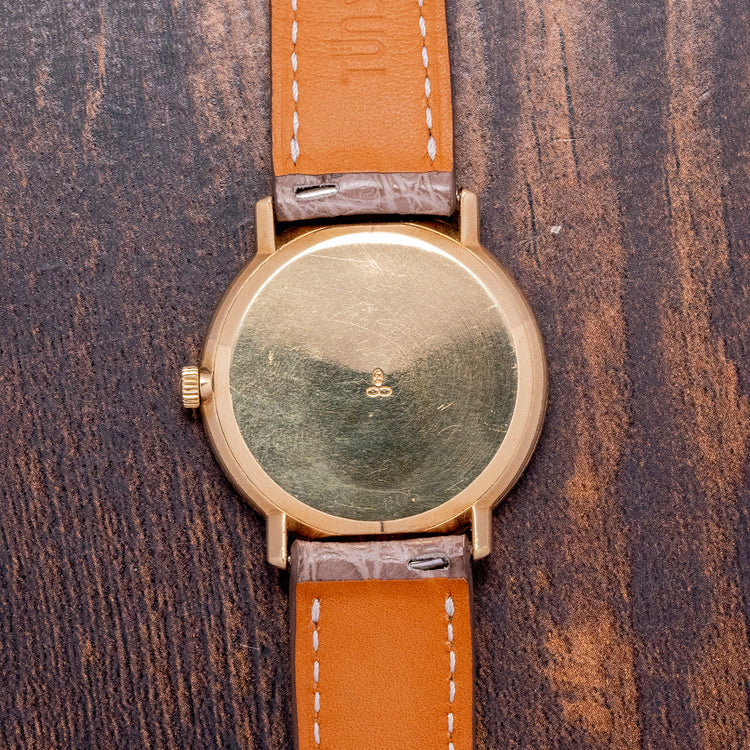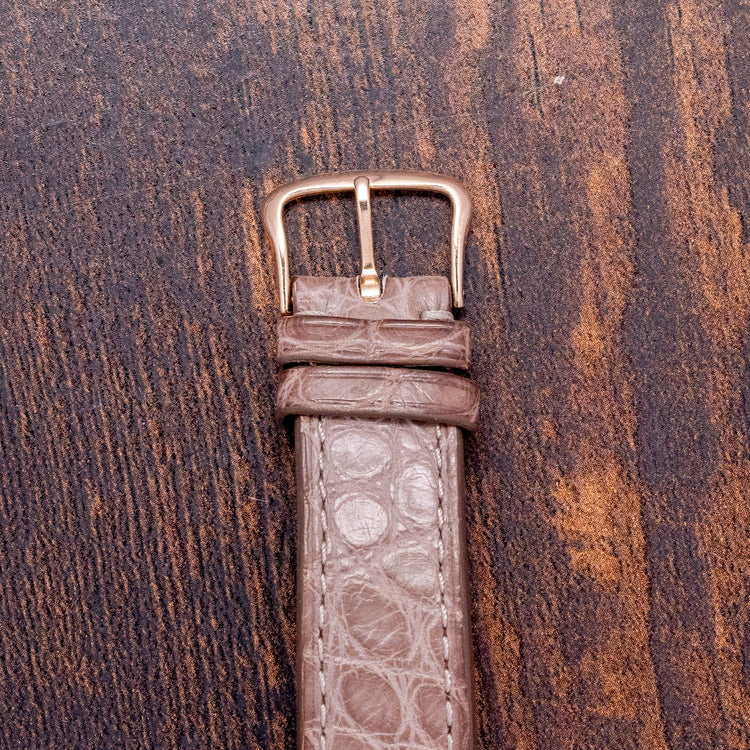More Information
Description
More
Less
More
Less
Here we have a stately and rare 1960s Movado 'Gentleman' 18ct Gold Micro-Rotor Cal. 230 with a curvaceous 34mm 18ct Yellow Gold case that gently curves over your wrist thanks to the straight lugs. Its curved flanks lead to a lug-to-lug length of 37mm and a case thickness of a slim 6mm, ensuring a comfortable fit on your wrist. On the right side is a signed coin-edged push-pull crown. The slim bezel holds a domed crystal above a striking linen-textured silver dial. Applied gold baton and Roman numeral indexes mark the hours; as you rotate your wrist, they magically catch the light; gold stick hands sit majestically in the centre; at 12 o’clock, we have the applied Movado motif “Automatic” printed underneath and at 6 o’clock “, gentlemen” completes this sophisticated dress watch. On the reverse, a snap-off case back, inside a rare Micro-Rotor Movado (UG) Cal. 230, 25 Jewels beating at 19,800 Beats per hour, this ultra-flat movement has a base of the Universal Geneve Cal. 1-66 and released in 1966, it was the world's thinnest automatic at that time. Its Micro-rotor uses four bearings to give it a smooth operation. It comes paired with a well-suited 18mm leather strap and an early 14ct yellow gold Movado pin buckle.
Points of Mention
More
Less
More
Less
This watch is sold as "Watch Only" and, therefore, comes with no original Movado box or paperwork. It is paired with a well-suited 18mm leather strap and an early 14ct gold Movado buckle. The watch is from Circa. 1960s and is sold in worn, vintage condition with signs of wear and age throughout; as you can see from the photographs, it is in all original condition. The watch comes with our 12-Months NON-Waterproof Warranty.
Personal Note
More
Less
More
Less
As a huge fan of vintage Movado, this is a reference I was fortunate enough to have owned and enjoyed for a little while, but unfortunately, you can't keep them all. This 'Gentleman' has a ton to offer, coming in an impressive 18ct yellow gold case featuring a delicate linen dial and applied gold markers, it is a work of art on and off the wrist. The best part is that hidden away, powering the watch, is a Movado Calibre 230. Don't be shocked if you have never heard or even seen this movement before, it was made by Universal Geneve for Movado and features their iconic micro-rotor, a very rare movement indeed and confirmation that the two brands did work together. With the increased demand for Universal Geneve, this only becomes more of a hidden gem in the vintage world and one I know for certain I will regret selling, so save me the pain and snap it up today whilst you can!
Specification
More
Less
More
Less
Reference : 2203
Movement : Micro-Rotor Movado (UG) Cal. 230
Age : Circa. 1960s
Year : Circa. 1960s
Case Size : 34mm
Case Thickness : 6mm
Lug to Lug : 37mm
Lugs : 18mm
Condition : Pre-Owned
Box and Papers : None
Case Material : 18ct Yellow Gold
Warranty : 12 Months NON-Waterproof Warranty
The wrist model's wrist size is 7inch
Movement : Micro-Rotor Movado (UG) Cal. 230
Age : Circa. 1960s
Year : Circa. 1960s
Case Size : 34mm
Case Thickness : 6mm
Lug to Lug : 37mm
Lugs : 18mm
Condition : Pre-Owned
Box and Papers : None
Case Material : 18ct Yellow Gold
Warranty : 12 Months NON-Waterproof Warranty
The wrist model's wrist size is 7inch
About Movado
More
Less
More
Less
Achilles Ditesheim, a visionary entrepreneur, embarked on his journey at the young age of 19 when he founded LAI Ditescheim & Freres SA in 1881. With a small team of six skilled watchmakers, he established a workshop in the quaint Swiss village of La Chaux-de-Fonds, a hub of horological craftsmanship known for its rich watchmaking heritage.
In 1905, recognising the need for a globally resonated brand, he rebranded the company as Movado, which translates to “always in motion” in Esperanto, the constructed international language designed for universal communication. This name would come to symbolise the brand’s commitment to forward-thinking design and innovation.
A seminal moment in Movado’s history came in 1912 with the introduction of the Polyplan, a groundbreaking watch design that captured the attention of the Swiss watch industry and earned the company its 20th patent. The Polyplan featured a revolutionary movement that consisted of three planes strategically angled to fit a case that conformed to the natural contours of the wrist, enhancing both aesthetics and comfort.
As the clouds of World War I gathered on the horizon, Movado swiftly designed the Soldier’s Watch, a remarkable blend of form and function. This timepiece featured a distinctive pierced metal cover that protected the watch crystal while allowing for easy readability of the time—a crucial feature for soldiers in the field.
Movado continued to push the boundaries of watchmaking innovation with the introduction of the Acvatic, the company’s first venture into water-resistant watches. The Acvatic was equipped with a patented Decagonal case design, a screw-down back featuring a lead gasket for enhanced waterproofing, and a cork seal that protected the crown for winding, making it a robust option for active wearers.
In 1945, Movado made another significant advancement in horology with the introduction of the Tempomatic. This marked the brand's first timepiece to incorporate an automatic movement, showcasing its commitment to integrating advanced technology into its designs.
The post-World War II era heralded a vibrant and innovative period for Movado. The company embraced the buoyant spirit of the times with a rapid succession of transformative products. Among these were the Calendomatic—the world’s first self-winding calendar watch, the innovative Celestograph—a watch that elegantly displayed the moon phases, and the Calendarmeto—a reinterpretation of the Ermeto that incorporated day, month, and moon phase complications, appealing to a wide range of customers.
In 1947, renowned designer Nathan George Horwitt unveiled the single-dot watch dial, which became a defining element of modern watch design. In 1960, Horwitt’s minimalist creation received high acclaim when it became the first watch dial ever to be accepted by the Museum of Modern Art in New York, solidifying Movado’s status in the realm of fine art and design.
Since its launch in 1956, the Movado Kingmatic has been an icon of mid-century design, symbolising the brand’s dedication to quality and precision in watchmaking.
At the 1969 Basel Fair, Movado made strides in the industry once again by partnering with Zenith to debut the world’s first automatic chronograph movement, the El Primero. This revolutionary innovation set new standards in watchmaking, reshaping the landscape of horology.
In 1983, as Movado entered its second century, Gedalio Grinberg acquired the company and integrated it into the North American Watch Corporation. This marked a new chapter in Movado's history as it aimed to broaden its reach and appeal in the North American market.
More recently, in 2017, Movado Group expanded its portfolio by acquiring Olivia Burton, a London-based brand renowned for its stylish fashion watches and jewelry, which ranks among the fastest-growing brands in the UK. Then, in October 2018, Movado Group further diversified its offerings with the acquisition of MVMT, a company focused on selling quartz watches, sunglasses, and jewelry. Today, the Movado Group continues to encompass several acclaimed brands, including Concord and Ebel, further solidifying its legacy as a leader in the watchmaking industry.
Description
Here we have a stately and rare 1960s Movado 'Gentleman' 18ct Gold Micro-Rotor Cal. 230 with a curvaceous 34mm 18ct Yellow Gold case that gently curves over your wrist thanks to the straight lugs. Its curved flanks lead to a lug-to-lug length of 37mm and a case thickness of a slim 6mm, ensuring a comfortable fit on your wrist. On the right side is a signed coin-edged push-pull crown. The slim bezel holds a domed crystal above a striking linen-textured silver dial. Applied gold baton and Roman numeral indexes mark the hours; as you rotate your wrist, they magically catch the light; gold stick hands sit majestically in the centre; at 12 o’clock, we have the applied Movado motif “Automatic” printed underneath and at 6 o’clock “, gentlemen” completes this sophisticated dress watch. On the reverse, a snap-off case back, inside a rare Micro-Rotor Movado (UG) Cal. 230, 25 Jewels beating at 19,800 Beats per hour, this ultra-flat movement has a base of the Universal Geneve Cal. 1-66 and released in 1966, it was the world's thinnest automatic at that time. Its Micro-rotor uses four bearings to give it a smooth operation. It comes paired with a well-suited 18mm leather strap and an early 14ct yellow gold Movado pin buckle.
Points of Mention
Personal Note
Specification
The Brand
Enquire or Book an Appointment
Would you like to discover further details about this watch, or perhaps arrange an appointment to view and try it on? Complete this form and a member of our team will get back to you shortly.
You May Also Like


























